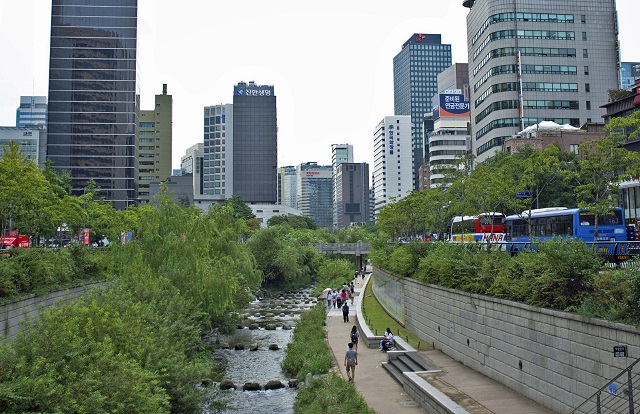
Road development throughout the 20th century was based primarily on the premise that more infrastructure eases traffic. But evidence shows that road building, instead of reducing congestion, actually increases traffic. When travel time by car is reduced and convenience increased, coupled with the appeal of the private vehicle as a continued indicator of wealth and standing, people are inclined to make more car trips. A recent working paper by researchers from the University of Barcelona, using data from 545 European cities from 1985-2005, confirms that capacity expansion efforts over two decades led to more vehicle traffic, not less, and congestion was not relieved.
A reverse effect to traffic generation is the phenomenon of “traffic evaporation”: traffic that disappears when road space is reallocated from private vehicles to more sustainable modes of transport like walking, cycling and public transportation. While traffic evaporation has been well-documented for more than 20 years, most decision- and opinion-makers are still under the impression that reducing car lanes will make traffic worse.
In 2001, researchers Cairns, Atkins and Goodwin published a paper in Municipal Engineer reviewing 70 road space reallocation cases, including testimonials from 200 traffic engineers and planners in multiple countries. The researchers concluded that predictions of unbearable traffic as a result of reallocating space away from private vehicles were, in most cases, alarmist. People adjusted their behavior in ways that traffic models did not accurately predict. When lanes were reassigned from car traffic to higher-capacity modes – sidewalks, bike lanes and bus or rail lanes – traffic issues were less severe than expected, and traffic volumes were significantly reduced.
Naturally, there were strong variations on this effect depending on the local context, background conditions and how the road space reallocation projects were planned and implemented, but the general results were more positive than negative. There was not a traffic apocalypse. Traffic was reduced not only for the roads where lanes were reassigned, but on nearby streets too in most cases. Out of 57 interventions where traffic was not completely shut down, 45 saw reductions in traffic and 11 increases. The maximum decrease in traffic was 60% and maximum increase 9%, with a simple average of 10% reduction.* In one case traffic remained the same before and after the intervention.
Why did this happen? According to the authors of the study, the projects in several cases included new traffic management plans, such as coordination of traffic signals, to make traffic more efficient. But in many cases, individual drivers changed not only their routes but their departure times, “flattening” out peaks in travel times. Other drivers changed their destinations (e.g., shopping in a different location) or consolidated their trips (a concept known as “trip chaining”), shared their vehicles with others or teleworked more often. Several months after the interventions, more people started moving to and working in areas with greater access to modes of transport other than cars, and even developers changed their plans. Road space reallocation seemed to ignite behavior changes and break habits of private car usage that may not have been broken otherwise.
More recently, European cities and some urban areas in the United States and Canada have further confirmed this effect, often through even more aggressive space reallocation initiatives.
The 2009 pedestrianization of Times Square in New York City is a notable example. According to local authorities, since the area was closed to traffic, pedestrian injuries have declined 40% and vehicular accidents by 15%. In London, in 2019, a bridge over the Thames was closed due to maintenance issues, and the press expected total chaos. But levels of noise and air pollution reduced significantly in the area around the bridge. Similar effects have been observed after the pedestrianization of downtown Copenhagen and the smart management of traffic parking in San Francisco and Zurich. One of the most emblematic cases is the demolition of the Cheonggyecheon elevated expressway in Seoul. Despite concerns that its demolition would exacerbate traffic problems, the long-feared increase in traffic never arrived.
All this does not mean that cities don’t require adequate road connectivity among rural areas and other cities. But reducing road space for cars in denser areas while improving areas for walking, cycling and public transportation clearly does not produce the chaos many believe it will. It is actually a more sustainable and equitable way of improving mobility in dense and fast-growing cities.
*Correction: An earlier version of the article miscalculated the traffic changes observed by Cairns et al. and included data from roads that were completely shut down.
A Spanish version of this blog was published by El Tiempo.
Dario Hidalgo is a Senior Mobility Consultant and supports WRI Ross Center for Sustainable Cities’ international team of transport engineers and planners from Bogotá.






